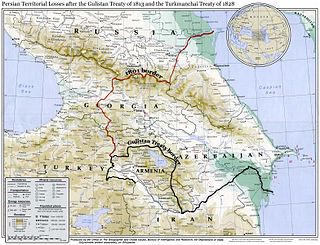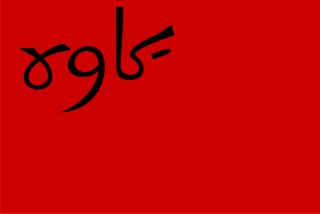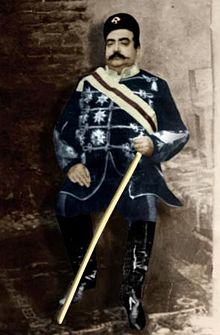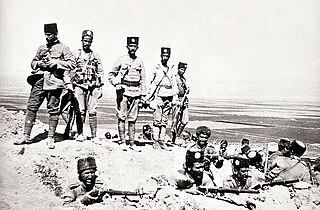
Gilan province is one of the 31 provinces of Iran, in the northwest of the country. Its capital is the city of Rasht. The province lies along the Caspian Sea, in Iran's Region 3, west of the province of Mazandaran, east of the province of Ardabil, and north of the provinces of Zanjan and Qazvin. It borders Azerbaijan in the north.

Iran is subdivided into thirty-one provinces, each governed from a local centre, usually the largest local city, which is called the capital of that province. The provincial authority is headed by a governor-general, who is appointed by the Minister of the Interior subject to approval of the cabinet.

Agha Mohammad Khan Qajar, also known by his regnal name of Agha Mohammad Shah, was the founder of the Qajar dynasty of Iran, ruling from 1789 to 1797 as Shah. Originally a chieftain of the Quwanlu branch of the Qajar tribe, Agha Mohammad Khan was enthroned as the king of Iran in 1789, but was not officially crowned until March 1796, having deposed Lotf Ali Khan of the Zand dynasty in 1794. Agha Mohammad Khan Qajar was famously the eunuch Monarch, being castrated as a toddler upon his capture by Adel Shah Afshar, and hence was childless. He was assassinated on 17 June 1797, and was succeeded by his nephew, Fath-Ali Shah Qajar.

Azerbaijan or Azarbaijan, also known as Iranian Azerbaijan, is a historical region in northwestern Iran that borders Iraq and Turkey to the west and Armenia, Azerbaijan, and the Azerbaijani exclave of the Nakhchivan Autonomous Republic to the north.

The Treaty of Gulistan was a peace treaty concluded between the Russian Empire and Qajar Iran on 24 October 1813 in the village of Gulistan as a result of the first full-scale Russo-Persian War. The peace negotiations were precipitated by the successful storming of Lankaran by General Pyotr Kotlyarevsky on 1 January 1813. It was the first of a series of treaties signed between Qajar Iran and Imperial Russia that forced Persia to cede the territories that formerly were part of Iran.

The Iranian Soviet Socialist Republic, also known as the Socialist Soviet Republic of Gilan, was a short-lived unrecognized state, a Soviet republic in north-west Persia, south of the Caspian sea. It lasted from June 1920 until September 1921 and was established by Mirza Kuchik Khan, a leader of the "Constitutionalist Movement of Gilan", and his Jangali partisans, with the assistance of the Soviet Russia's Red Army.
The Russo-Persian Wars or Russo-Iranian Wars were a series of conflicts between 1651 and 1828, concerning Persia and the Russian Empire. Russia and Persia fought these wars over disputed governance of territories and countries in the Caucasus. The main territories disputed were Aran, Georgia and Armenia, as well as much of Dagestan – generally referred to as Transcaucasia – and considered part of the Safavid Iran prior to the Russo-Persian Wars. Over the course of the five Russo-Persian Wars, the governance of these regions transferred between the two empires. Between the Second and Third Russo-Persian Wars, there was an interbellum period in which a number of treaties were drawn up between the Russian and the Persian Empires, as well as between both parties and the Ottoman Empire. Ottoman interest in these territories further complicated the wars, with both sides forming alliances with the Ottoman Empire at different points throughout the wars. Following the Treaty of Turkmenchay, which concluded the Fifth Russo-Persian War, Persia ceded much of its Transcaucasian territory to the Russian Empire.
Iranian Armenians, also known as Persian Armenians, are Iranians of Armenian ethnicity who may speak Armenian as their first language. Estimates of their number in Iran range from 70,000 to 500,000. Areas with a high concentration of them include Tabriz, Tehran, Salmas and New Julfa, Isfahan.

Relations between the Grand Duchy of Moscow and the Persian Empire (Iran) officially commenced in 1521, with the Safavids in power. Past and present contact between Russia and Iran have long been complicatedly multi-faceted; often wavering between collaboration and rivalry. The two nations have a long history of geographic, economic, and socio-political interaction. Mutual relations have often been turbulent, and dormant at other times.

The Persian campaign or invasion of Iran was a series of military conflicts between the Ottoman Empire, British Empire and Russian Empire in various areas of what was then neutral Qajar Iran, beginning in December 1914 and ending with the Armistice of Mudros on 30 October 1918, as part of the Middle Eastern Theatre of World War I. The fighting also involved local Persian units, who fought against the Entente and Ottoman forces in Iran. The conflict proved to be a devastating experience for Persia. Over 2 million Persian civilians died in the conflict, mostly due to the Armenian genocide by the Ottoman regime and Persian famine of 1917–1919, influenced by British and Russian actions. The Qajar government's inability to maintain the country's sovereignty during and immediately after the First World War led to a coup d'état in 1921 and Reza Shah's establishment of the Pahlavi dynasty.

Vladimir Fyodorovich Minorsky was a Russian academic, historian, and scholar of Oriental studies, best known for his contributions to the study of history of Iran and the Iranian peoples such as Persians, Laz people, Lurs, and Kurds.

The following outline is provided as an overview of and topical guide to Iran:

The first level of country subdivisions of Iran are the provinces . Each province is further subdivided into counties called shahrestan, and each county is subdivided into districts called bakhsh. There are usually a few cities and rural districts called dehestan in each district. Rural districts are a collection of a number of villages. One of the cities of the county is appointed as the capital of the county.
1921 Persian coup d'état, known in Iran as 3 Esfand 1299 coup d'état, refers to several major events in Qajar Persia in 1921, which eventually led to the deposition of the Qajar dynasty and the establishment of the Pahlavi dynasty as the ruling house of Iran in 1925.

Akaki Khoshtaria was a Georgian entrepreneur, socialite, and philanthropist. His principal business interests centered on oil industry in Azerbaijan and northern Iran.

Gīlān is an Iranian province at the southwestern coast of the Caspian Sea. This articles discusses its history.

Sardar Rafie Yanehsari (1856-1930) was the Wali of velayat of Astarabad and Governor of Gorgan from the time of Naser el-Din Shah to Reza Shah and was a member of Yanehsari Dynasty. Sardar Rafi played a major role in the development of the areas under his rule, the first explorations in Gorgan, the first carvings in Tepe Hisar, the construction of the road between Gorgan and Tehran and the introduction of modern science to Gorgan, Only part of his activity was during his 39 years of rule. Sardar Rafi first came to power in February 1892, when he was succeeded by his father, Lotf Ali Khan Sartip, who ruled the Hezarjarib region and rose to the rank of brigadier general. In addition to his services to modernize the areas under his rule, he and his nephew, Amir Khan-e Sardar, played an important role in suppressing Turkmen insurgency.

The Guarded Domains of Iran, alternatively the Sublime State of Iran and commonly called Qajar Iran, Qajar Persia or the Qajar Empire, was the Iranian state under the rule of the Qajar dynasty, which was of Turkic origin, specifically from the Qajar tribe, from 1789 to 1925. The Qajar family took full control of Iran in 1794, deposing Lotf 'Ali Khan, the last Shah of the Zand dynasty, and re-asserted Iranian sovereignty over large parts of the Caucasus. In 1796, Agha Mohammad Khan Qajar seized Mashhad with ease, putting an end to the Afsharid dynasty. He was formally crowned as Shah after his punitive campaign against Iran's Georgian subjects.
Konstantin Nikolaevich Smirnov was a military Orientalist of the Imperial Russian Army, having the rank of Staff Captain.

The Swedish volunteers in Persia were a small group of military officers active in Persia between 1911 and 1916. The goal was to quell regional uprisings and modernize the Persian army, but as a result of pressure from Russia and the United Kingdom, Sweden decided to call back most of their officers during World War I.















